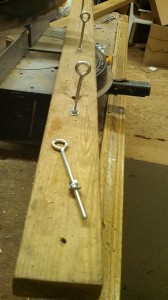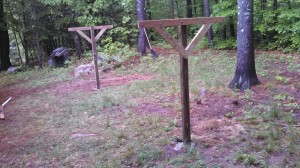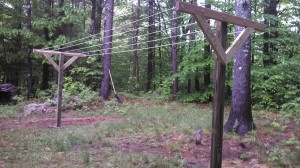Last year, we decided to make a small investment in one of those soft-sided swimming pools that we have been noticing pop up lately. I thought at first that these were “disposable” pools, maybe good for a year and then get a new one. While they are affordable enough to do that with, I have a good friend that got three years out of his before it needed to be retired. A little bit of care can make these last for a few seasons.
Last year, I was in a hurry to assemble the pool and get it filled (it was HOT!), and I learned that “the ground LOOKS level” does not mean “the ground IS level”. I dug out what I thought was the high side and filled in what I thought was the low side. I don’t know if I dug out too much or filled in too much, but when the pool was full, what I was expecting to be level turned out to be almost 2″ off from one side of the pool to the other. I had actually done too much work, and overcompensated for the slope to the point where the pool was out of level in the opposite direction! By half way through the season, I had put some straps on the frame on the “uphill” side of the pool, and tied them to rebar stakes I had driven into the ground, just in case that would help to hold the pool upright for the remainder of the season.
This year, I took a little more time in doing site prep. I purchased a patio paver to go under each frame upright, and leveled them. I then contoured the sand under the pool to conform to the now-level pavers. I did rake it in a slight “cone” shape, so the middle of the pool is about 6″ deeper than it is along the edge of the pool.
I also put some 1″ styrofoam under the pool this year, which is comfy on the feet, and I figure that this serves as an extra level of protection for the liner. Even with raking and adding sand last year, I was still feeling sharp pieces of “sand” and roots under the liner. I would imagine that those types of things will drastically shorten the life expectancy of a liner. The foam cost me about $50, but I am definitely a fan!
Last year, our first fill of the pool was green. Not algae – something in our water was actually green right out of the well (we didn’t notice the green tint until the pool was filled about half-way, so it’s not like we notice it coming out of the tap as green!). A couple of doses of shock and quite a few filter cleanings later, it was clear. But it didn’t stay clear, it got cloudy, and it was cloudy for the rest of the season. I believe that the pump included with the pool is not adequate. The manual says we should only need to run the pump 3 hours a day, but we were running it 24/7 and losing the battle!
This year, the water started off clear, and very quickly turned green (I had it up before the pollen hit hard, and that’s where I lost the clarity). I’ve added clarifier, balanced the pH, shocked and super-shocked the water…. nothing is working, because the pump is under-performing. Somewhere along the line, it is taking on air as well. After 12 hours, the filter chamber is half filled with air, and I’m not sure where it’s coming from.
Part way into the season, I ordered a new Intex 633 filter pump. It has more than double the volume (the 637R that came with the pool was rated for 1000 gallons per hour, and the 633 is rated at 2500 gph). I used the adapters that came with the pump kit (otherwise sold as an accessory), so I did not have to modify the openings in the liner at all. Since the openings are smaller, I am sure that we are not getting the full 2500 gph flow, but whatever it is that we are getting is sufficient to maintain the pool. The water is visibly churned by this pump when it is on, and it only needs to run for a couple of hours each day (it has a built-in timer, which is nice). This pump is a much better design than the one that came with the pool.








